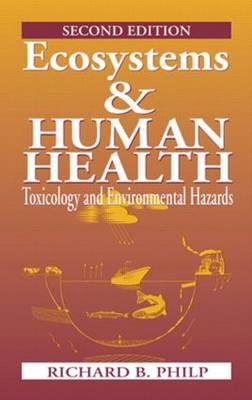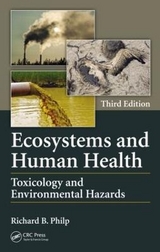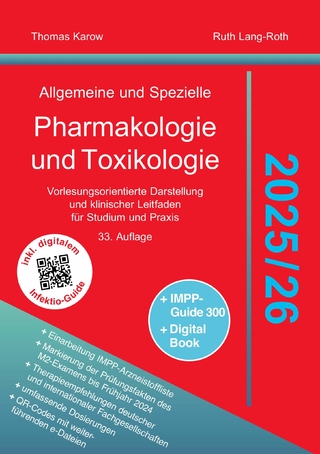
Ecosystems and Human Health
Lewis Publishers,U.S. (Verlag)
978-1-56670-568-4 (ISBN)
- Titel erscheint in neuer Auflage
- Artikel merken
Renamed to reflect the expanded scope of the second edition, Ecosystems and Human Health: Toxicology and Environmental Hazards builds on the foundation created by the author in the first edition, Environmental Hazards and Human Health. Written in a journalistic, easily accessible style, this book bridges the gap between toxicology and environmental sciences by exploring man-made and natural hazards, and the risks they pose to wildlife and human health.
See what's new in the Second Edition:
Coverage of environmental hormone disrupters
Section on Multiple Chemical Sensitivity
Expanded discussion of the controversy over genetically modified foods
New information on mechanisms of action of marine venoms and poisons
Ecosystems and Human Health: Toxicology and Environmental Hazards, Second Edition explores the broad range of environmental and human health aspects of chemical and biological hazards. The author covers the basic principles of pharmacology and toxicology as well as risk analysis, air and water pollution, and various toxicants, hazards, and poisons. He presents numerous examples of the intimate relationship between ecosystem health and human health and of the need to consider this relationship whenever human activities are likely to have a significant environmental impact.
PRINCIPLES OF PHARMACOLOGY AND TOXICOLOGY
Introduction
Pharmacokinetics
Pharmacodynamics
Factors Influencing Responses to Xenobiotics
Some Toxicological Considerations
Mutagenesis and Carcinogenesis
The Role of Cell Repair and Regeneration in Toxic Reactions
Fetal Toxicology
Further Reading
Review Questions
RISK ANALYSIS AND PUBLIC PERCEPTIONS OF RISK
Introduction
Assessment of Toxicity vs. Risk
Predicting Risk: Workplace vs. The Environment
Risk Assessment and Carcinogenesis
Sources of Error in Predicting Cancer Risk
Environmental Monitoring
Setting Safe Limits in the Workplace
Environmental Risks: Problems with Assessment and Public Perceptions
Some Examples of Major Industrial Accidents and Environmental Chemical Exposures with Human Health Implications
Some Legal Aspects of Risk
Statistical Problems with Risk Assessment
Risk Management
Further Reading
Review Questions
Case Studies 1 - 2
WATER AND SOIL POLLUTION
Introduction
Factors Affecting Toxicants in Water
Toxicity Testing in Marine and Aquatic Species
Water Quality
Health Hazards of Pesticides and Related Chemicals
Acidity and Toxic Metals
Chemical Hazards from Waste Disposal
Toxicants in the Great Lakes: Implications for Human Health and Wildlife
The Marine Environment
Aquatic Toxicology
Biological Hazards in Drinking Water
Further Reading
Review Questions
AIRBORNE HAZARDS
Introduction
Types of Air Pollution
Sources of Air Pollution
Atmospheric Distribution of Pollutants
Types of Pollutants
Health Effects of Air Pollution
Air Pollution in the Workplace
Chemical Impact of Pollutants on the Environment
Global Warming
Global Cooling: New Ice Age?
Natural Factors and Climate Change
Remedies
Further Reading
Review Questions
Case Studies 3 - 8
HALOGENATED HYDROCARBONS AND HALOGENATED AROMATIC HYDROCARBONS
Introduction
Physicochemical Characteristics and Classes of Halogenated Hydrocarbons
Further Reading
Review Questions
Case Studies 9 - 10
TOXICITY OF METALS
Introduction
Lead
Mercury
Cadmium
Arsenic
Chromium
Other Metals
Methallothioneins
Carcinogenicity of Metals
Unusual Sources of Heavy Metal Exposure
Further Reading
Review Questions
Case Studies 11 - 13
ORGANIC SOLVENTS AND RELATED CHEMICALS
Introduction
Classes of Solvents
Solvent-Related Cancer in the Workplace
Factors Influencing the Risk of a Toxic Reaction
Non-occupational Exposures to Solvents
Further Reading
Review Questions
Case Studies 14 - 16
FOOD ADDITIVES, DRUG RESIDUES AND FOOD TOXICANTS
Food Additives
Drug Residues
Natural Toxicants and Carcinogens in Human Foods
Further Reading
Review Questions
Case Study 17
PESTICIDES
Introduction
Classes of Insecticides
Herbicides
Fungicides
Newer Biological Control Methods
Government Regulation of Pesticides
Problems Associated with Pesticides
Balancing the Risks and the Benefits
Toxicity of Pesticides for Humans
Further Reading
Review Questions
Case Studies 18 - 19
MYCOTOXINS AND OTHER TOXINS FROM UNICELLULAR ORGANISMS
Introduction
Some Human Health Problems Due to Mycotoxins
Economic Impact of Mycotoxins
Trichothecenes
Detoxification of Grains
Other Toxins in Unicellular Members of the Plant Kingdom
Further Reading
Review Questions
ANIMAL AND PLANT POISONS
Introduction
Toxic and Venomous Animals
Toxic Plants and Mushrooms
Use in Research and Treatment
Further Reading
Review Questions
Case Studies 20 - 25
ENVIRONMENTAL HORMONE DISRUPTERS
Introduction
The Lake Apopka Incident
A Brief Review of the Physiology of Estrogens and Androgens
Mechanisms of Hormone Disruption
Phytoestrogens
Results of Human Studies
Effects in Livestock and Wildlife
Problems in interpreting and Extrapolating Results to Humans
Further Reading
Review Questions
RADIATION HAZARDS
Introduction
Sources and Types of Radiation
Measurement of Radiation
Major Nuclear Disasters of Historic Importance
Radon Gas: The Natural Radiation
Tissue Sensitivity to Radiation
Microwaves
Ultraviolet Radiation
Extra-low Frequency (ELF) Electromagnetic Radiation
Irradiation of Foodstuffs
Further Reading
Review Questions
GAIA AND CHAOS: HOW THINGS ARE CONNECTED
The GAIA Hypothesis
Chaos Theory
Other Examples of Interconnected Systems
Food Production and the Environment
The Environment and Cancer
Further Reading
CASE STUDY REVIEWS
| Erscheint lt. Verlag | 27.6.2001 |
|---|---|
| Zusatzinfo | 51 Illustrations, black and white |
| Verlagsort | London |
| Sprache | englisch |
| Maße | 156 x 234 mm |
| Gewicht | 658 g |
| Themenwelt | Medizin / Pharmazie ► Medizinische Fachgebiete ► Arbeits- / Sozial- / Umweltmedizin |
| Studium ► 2. Studienabschnitt (Klinik) ► Pharmakologie / Toxikologie | |
| Naturwissenschaften ► Biologie ► Ökologie / Naturschutz | |
| ISBN-10 | 1-56670-568-1 / 1566705681 |
| ISBN-13 | 978-1-56670-568-4 / 9781566705684 |
| Zustand | Neuware |
| Haben Sie eine Frage zum Produkt? |
aus dem Bereich



